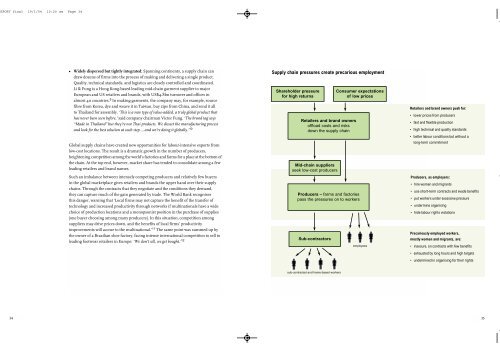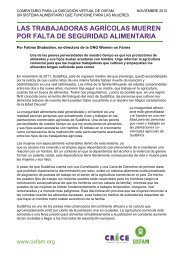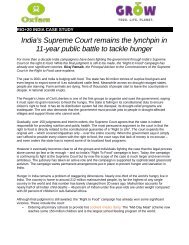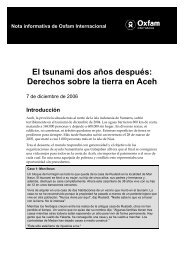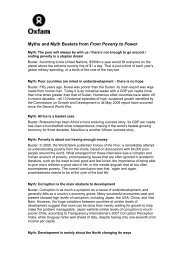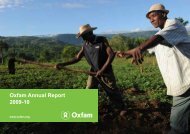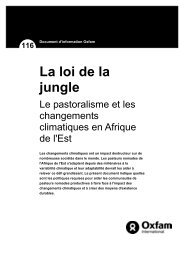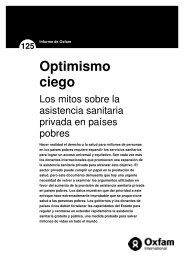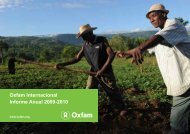EPORT final 19/1/04 10:20 am Page 34• Widely dispersed but tightly integrated: Spanning continents, a supply chain candraw dozens of firms into the process of making and delivering a single product.Quality, technical standards, and logistics are closely controlled and coordinated.Li & Fung is a Hong Kong-based leading mid-chain garment supplier to majorEuropean and US retailers and brands, with US$4.8bn turnover and offices inalmost 40 countries. 9 In making garments, the company may, for example, sourcefibre from Korea, dye and weave it in Taiwan, buy zips from China, and send it allto Thailand for assembly. ‘This is a new type of value-added, a truly global product thathas never been seen before,’ said company chairman Victor Fung. ‘The brand tag says“Made in Thailand” but they’re not Thai products. We dissect the manufacturing processand look for the best solution at each step … and we’re doing it globally.’ 10Global supply chains have created new opportunities for labour-intensive exports fromlow-cost locations. The result is a dramatic growth in the number of producers,heightening competition among the world’s factories and farms for a place at the bottom ofthe chain. At the top end, however, market share has tended to consolidate among a fewleading retailers and brand names.Such an imbalance between intensely competing producers and relatively few buyersin the global marketplace gives retailers and brands the upper hand over their supplychains. Through the contracts that they negotiate and the conditions they demand,they can capture much of the gain generated by trade. The World Bank recognisesthis danger, warning that ‘Local firms may not capture the benefit of the transfer oftechnology and increased productivity through networks if multinationals have a widechoice of production locations and a monopsonist position in the purchase of supplies[one buyer choosing among many producers]. In this situation, competition amongsuppliers may drive prices down, and the benefits of local firms’ productivityimprovements will accrue to the multinational.’ 11 The same point was summed up bythe owner of a Brazilian shoe factory, facing intense international competition to sell toleading footwear retailers in Europe: ‘We don’t sell, we get bought.’ 12Supply chain pressures create precarious employmentShareholder pressurefor high returnsRetailers and brand ownersoffload costs and risksdown the supply chainMid-chain suppliersseek low-cost producersSub-contractorsConsumer expectationsof low pricesProducers – farms and factoriespass the pressures on to workersemployeesRetailers and brand owners push for:• lower prices from producers• fast and flexible production• high technical and quality standards• better labour conditions but without along-term commitmentProducers, as employers:• hire women and migrants• use short-term contracts and evade benefits• put workers under excessive pressure• undermine organising• hide labour rights violationsPrecariously employed workers,mostly women and migrants, are:• insecure, on contracts with few benefits• exhausted by long hours and high targets• undermined in organising for their rightssub-contracted and home-based workers3435
EPORT final 19/1/04 10:20 am Page 36Retailers and brands face three main sources of pressure which influence their supply chainstrategies:• Shareholder expectations: publicly quoted companies face intense pressure fromtheir shareholders – especially major institutional investors such as pension fundsand insurance firms – to deliver short-term returns in excess of 10 per cent on capitalemployed. Many companies deliver those results by stripping out low-profit activitiesand minimising the cash used in running the business.• Customer loyalty: consumers have come to expect high quality and year-roundavailability at ‘value’ prices. Many retailers and brands compete to capture theirloyalty through new products, short fashion cycles, and price wars, and so increasetheir own market share.• Ethical pressure: unions, NGOs, concerned consumers, and socially responsibleinvestors pressure high-profile companies to improve labour standards in theirsupply chains, through media exposure, campaigns, shareholder resolutions, andconsumer pressure.In an attempt to deal with all three, many retail and brand sourcing companies combinecutting-edge logistics with hefty bargaining power to push costs and risks down theirsupply chains. 13 Many have signed up to codes of conduct requiring compliance withlabour standards down the chain – but when these interests clash, something has to give.Just-in-time deliveryElectronic point-of-sale technology – that is, the barcode – has been increasing retailers’command over suppliers since the 1980s. Retailers no longer have to buy goods upfrontand carry the risk of selling them. Now, when consumer purchases are tracked bybarcodes, retailers can automatically reorder just enough products, just in time forrestocking their shelves. It maximises their retail sales per square metre of shop space,and shifts order risks back onto suppliers and producers. 14 With this just-in-timeresponse comes the pressure on producers to deliver smaller orders, in less time,and according to tightly planned shipping schedules – or face fines for delays.High quality and technical standardsRetail and brand buyers demand reliable quality and high technical and safety standardsfrom their suppliers, who demand it from producers. In the competition to supply,these criteria are becoming more stringent. To stay in the chain, producers must meetthe standards of higher quality control, greater traceability, tighter control overhazardous inputs, and better record keeping – all at their own expense.The buying gameBuyers working for retailers and brands operate in a business culture of performancetargets and incentives which encourage them to squeeze suppliers on price and deliverytimes, with scant attention to the ethical repercussions down the supply chain.High pressure to performBuyers are often given only 12 to 18 months to prove themselves before being moved ontoa new product. ‘You can try to negotiate but you don’t want to upset them,’ said oneSouth African grape farmer selling to several UK supermarkets. ‘Every two years there’sa new buyer, under pressure to perform – they must make margins and raise turnover, andthey’ve got their ways and means of doing it.’ 15 It leaves little room for building long-termrelations and understanding with producers.Ethical standards: out of the pictureBuyers may get training or ‘awareness raising’ in ethical issues, but it is rarely integratedinto the targets on which they are judged. According to one former fresh-food buyer at aleading UK supermarket, ‘Buyers are caught in a high-pressure culture of weekly reportingon their sales and pro fit margin targets. Ethical trade just doesn’t fit neatly into numbers andso it gets left out of the picture.’ 16Split personalitiesBuying teams and ethical teams often sit in different company divisions, face conflictingperformance targets, and put contradictory demands on producers. Producers are wellaware of this disjointed approach. ‘I know how to deal with the ethical code people frommy many years’ experience,’ said one factory manager in Shenzhen, China. ‘I can judge thebalance of power between buying departments and those responsible for codes of conductto see where the real power lies.’ 17Pushing down pricesBuyers employed by many retailers and brands are given strong incentives to cut theprices they pay. Some use Internet ‘reverse auctions’, pitching suppliers into intensecompetition. Others demand ‘open book costing’ that requires suppliers and producersto reveal their production and delivery costs so that retailers can cut out low-value steps,and capture the saving in lower prices. Some boost their profits by charging suppliersfor product promotions, for store displays, for discounts on poorly selling goods,for discounts on well-selling goods, and even for simply being listed as a supplier.3637


